Understanding Welfare Systems and Services: A Case Study Report
VerifiedAdded on 2022/11/03
|11
|2513
|342
AI Summary
This report identifies a particular case study and helps understand not only how several factors affect need of a person or a group, but also what are the structures and frameworks in place that can help the person in need.
Contribute Materials
Your contribution can guide someone’s learning journey. Share your
documents today.
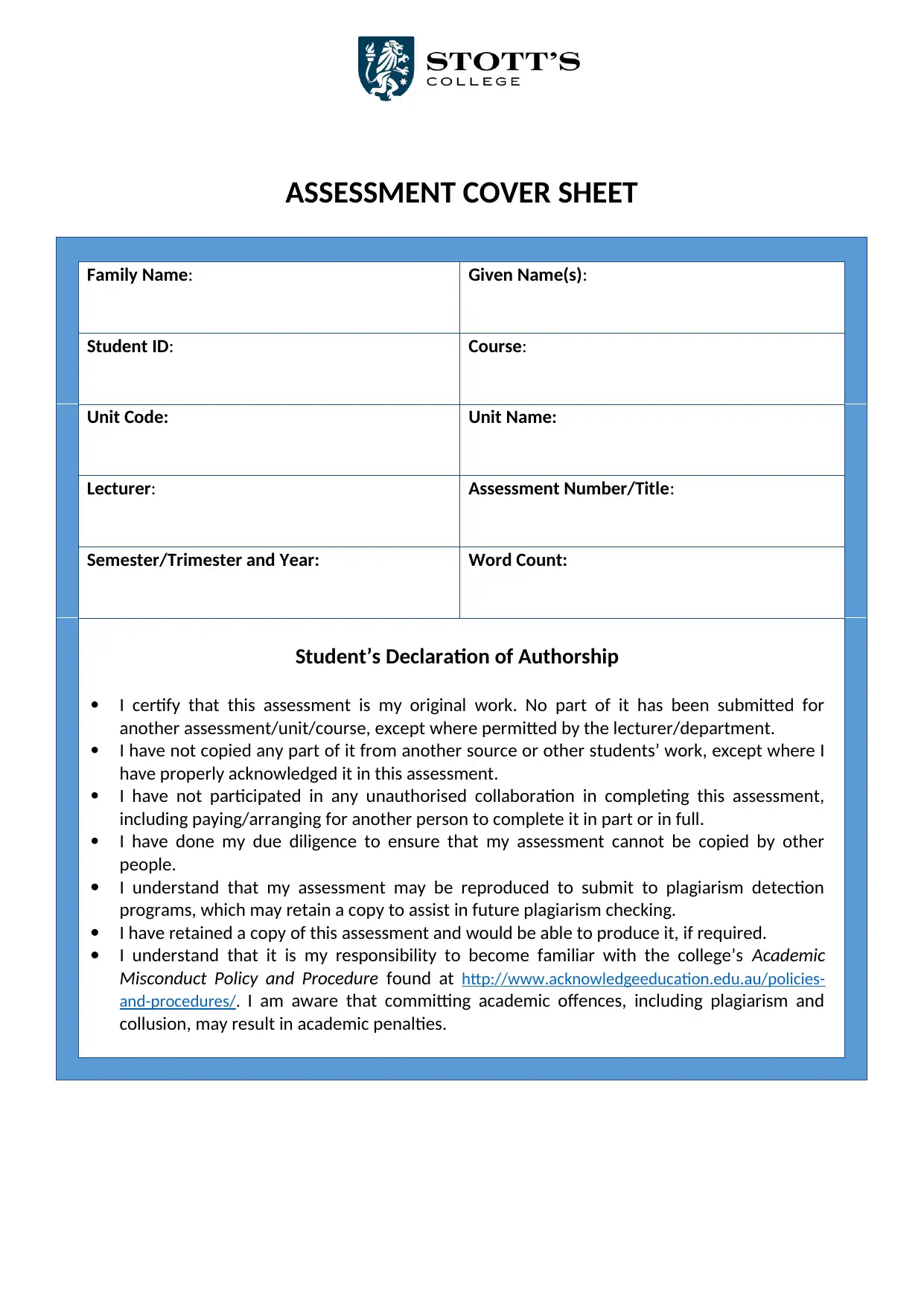
ASSESSMENT COVER SHEET
Family Name: Given Name(s):
Student ID: Course:
Unit Code: Unit Name:
Lecturer: Assessment Number/Title:
Semester/Trimester and Year: Word Count:
Student’s Declaration of Authorship
I certify that this assessment is my original work. No part of it has been submitted for
another assessment/unit/course, except where permitted by the lecturer/department.
I have not copied any part of it from another source or other students’ work, except where I
have properly acknowledged it in this assessment.
I have not participated in any unauthorised collaboration in completing this assessment,
including paying/arranging for another person to complete it in part or in full.
I have done my due diligence to ensure that my assessment cannot be copied by other
people.
I understand that my assessment may be reproduced to submit to plagiarism detection
programs, which may retain a copy to assist in future plagiarism checking.
I have retained a copy of this assessment and would be able to produce it, if required.
I understand that it is my responsibility to become familiar with the college’s Academic
Misconduct Policy and Procedure found at http://www.acknowledgeeducation.edu.au/policies-
and-procedures/. I am aware that committing academic offences, including plagiarism and
collusion, may result in academic penalties.
Family Name: Given Name(s):
Student ID: Course:
Unit Code: Unit Name:
Lecturer: Assessment Number/Title:
Semester/Trimester and Year: Word Count:
Student’s Declaration of Authorship
I certify that this assessment is my original work. No part of it has been submitted for
another assessment/unit/course, except where permitted by the lecturer/department.
I have not copied any part of it from another source or other students’ work, except where I
have properly acknowledged it in this assessment.
I have not participated in any unauthorised collaboration in completing this assessment,
including paying/arranging for another person to complete it in part or in full.
I have done my due diligence to ensure that my assessment cannot be copied by other
people.
I understand that my assessment may be reproduced to submit to plagiarism detection
programs, which may retain a copy to assist in future plagiarism checking.
I have retained a copy of this assessment and would be able to produce it, if required.
I understand that it is my responsibility to become familiar with the college’s Academic
Misconduct Policy and Procedure found at http://www.acknowledgeeducation.edu.au/policies-
and-procedures/. I am aware that committing academic offences, including plagiarism and
collusion, may result in academic penalties.
Secure Best Marks with AI Grader
Need help grading? Try our AI Grader for instant feedback on your assignments.
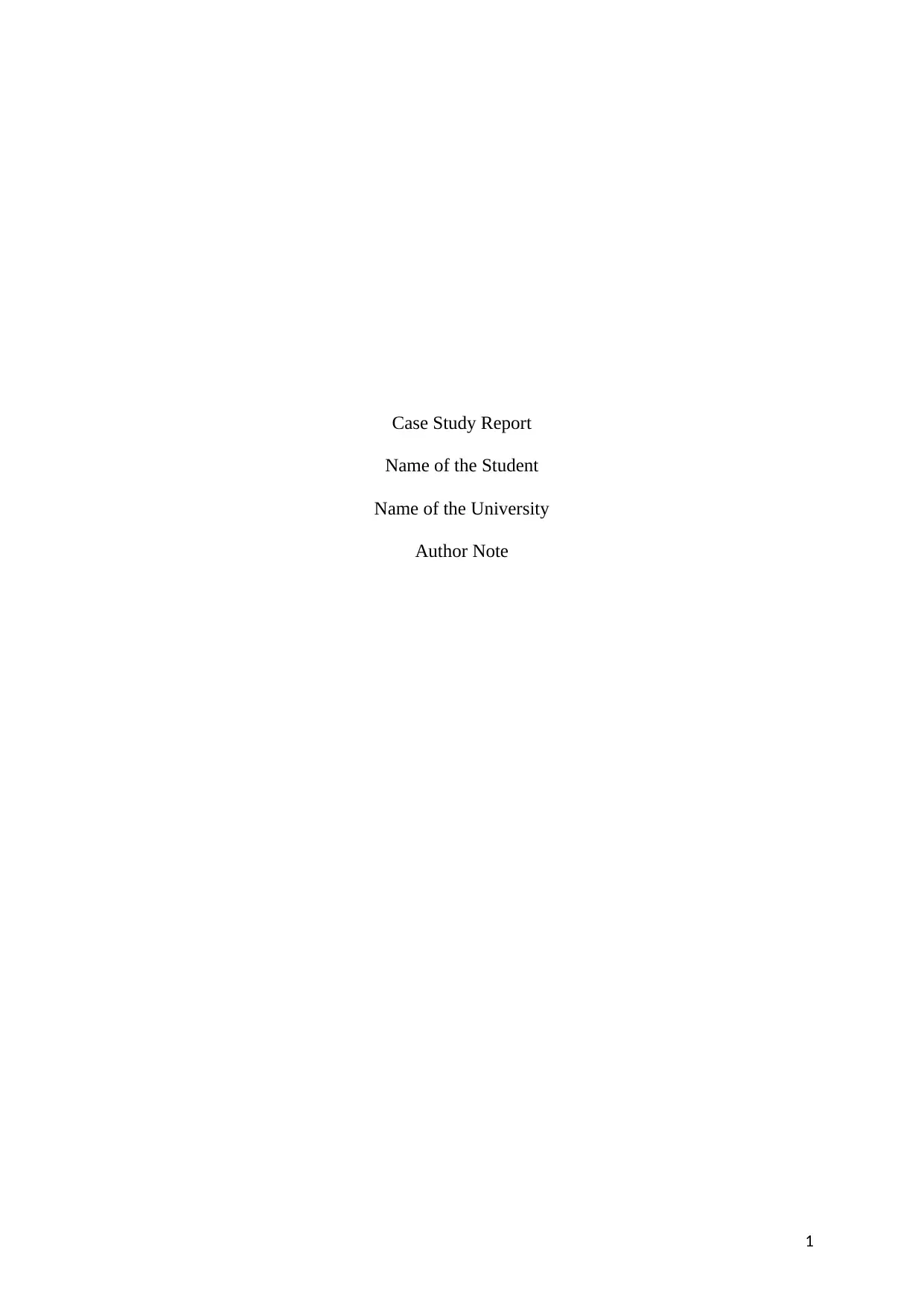
Case Study Report
Name of the Student
Name of the University
Author Note
1
Name of the Student
Name of the University
Author Note
1
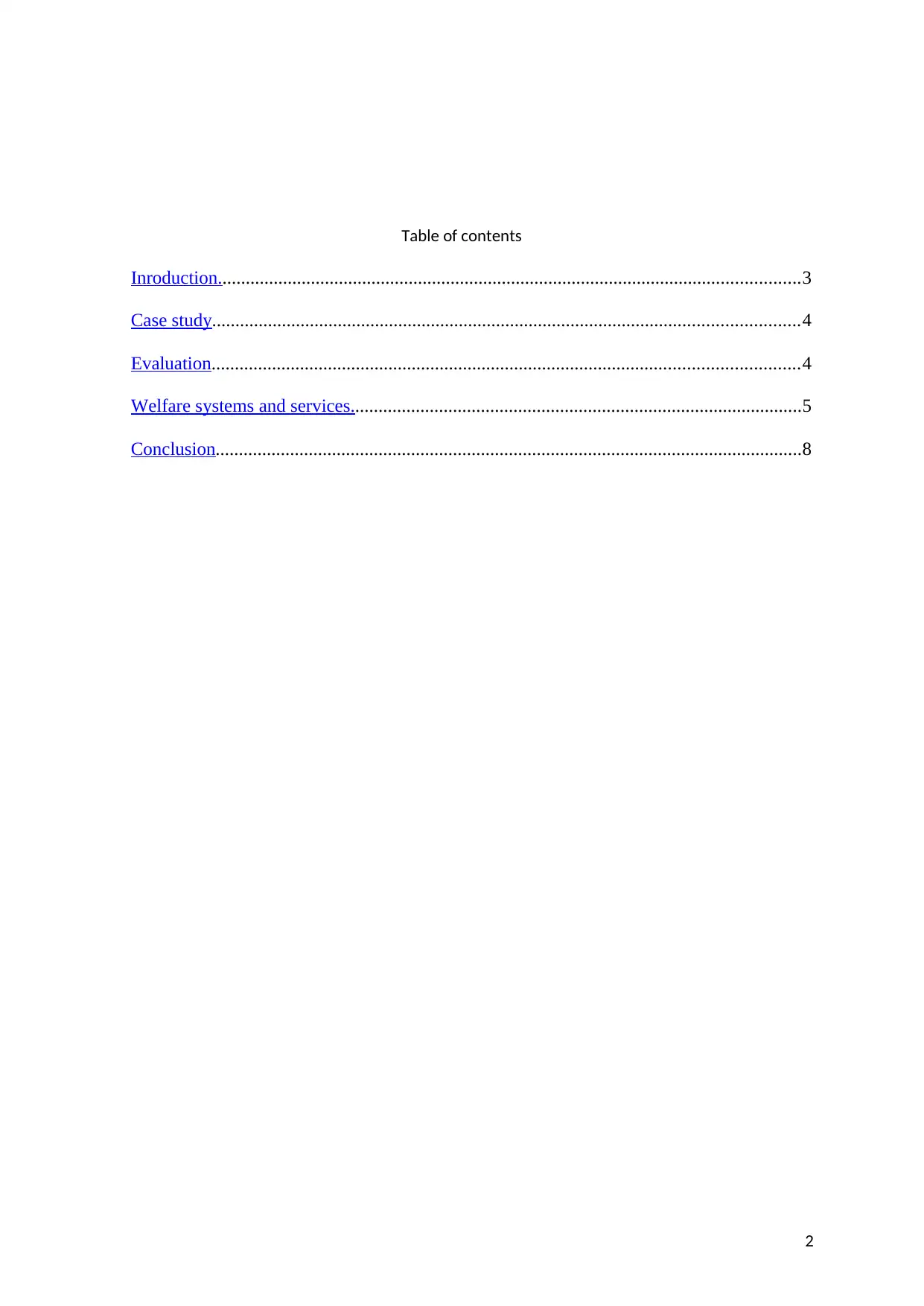
Table of contents
Inroduction.............................................................................................................................3
Case study..............................................................................................................................4
Evaluation..............................................................................................................................4
Welfare systems and services.................................................................................................5
Conclusion..............................................................................................................................8
2
Inroduction.............................................................................................................................3
Case study..............................................................................................................................4
Evaluation..............................................................................................................................4
Welfare systems and services.................................................................................................5
Conclusion..............................................................................................................................8
2
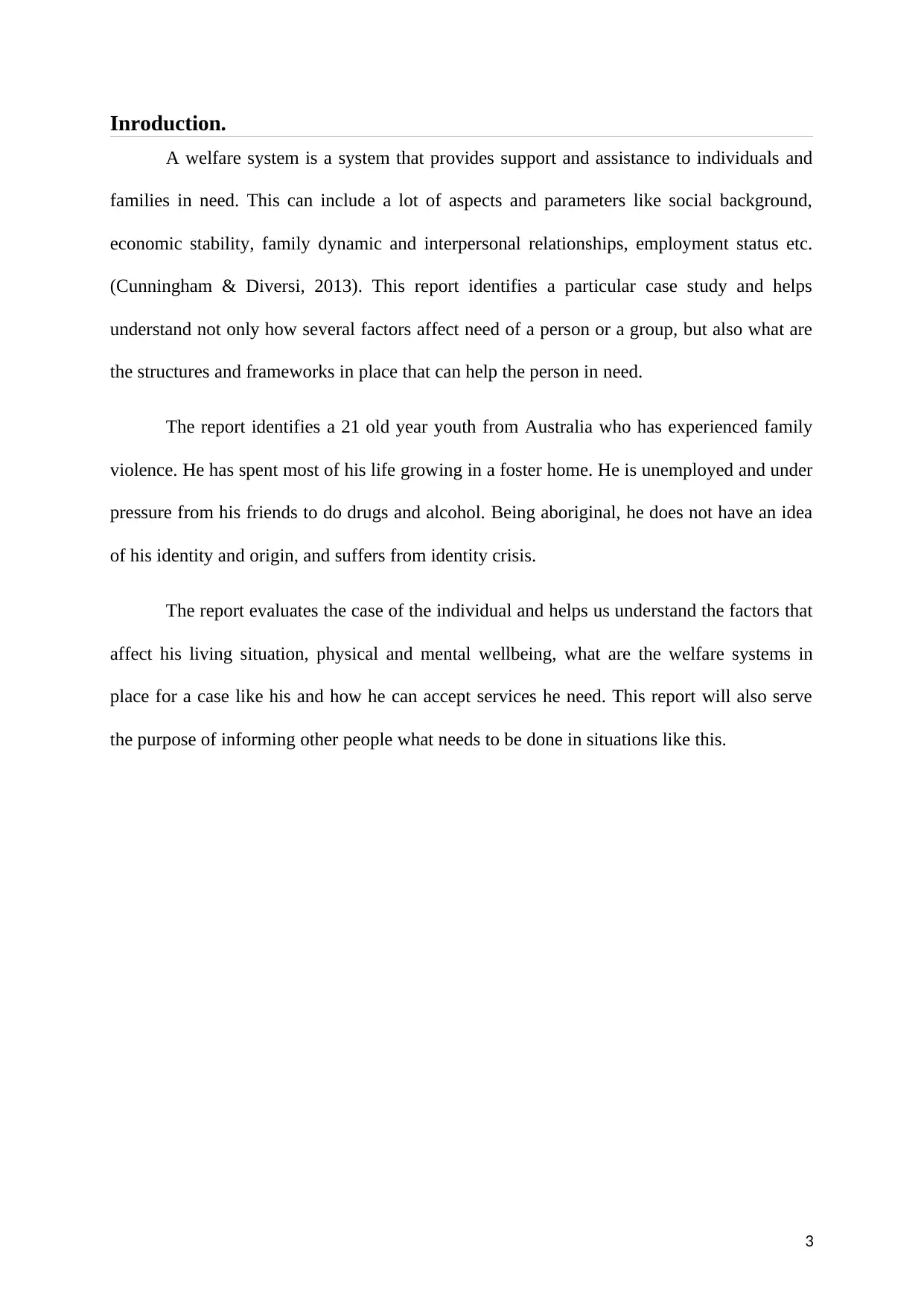
Inroduction.
A welfare system is a system that provides support and assistance to individuals and
families in need. This can include a lot of aspects and parameters like social background,
economic stability, family dynamic and interpersonal relationships, employment status etc.
(Cunningham & Diversi, 2013). This report identifies a particular case study and helps
understand not only how several factors affect need of a person or a group, but also what are
the structures and frameworks in place that can help the person in need.
The report identifies a 21 old year youth from Australia who has experienced family
violence. He has spent most of his life growing in a foster home. He is unemployed and under
pressure from his friends to do drugs and alcohol. Being aboriginal, he does not have an idea
of his identity and origin, and suffers from identity crisis.
The report evaluates the case of the individual and helps us understand the factors that
affect his living situation, physical and mental wellbeing, what are the welfare systems in
place for a case like his and how he can accept services he need. This report will also serve
the purpose of informing other people what needs to be done in situations like this.
3
A welfare system is a system that provides support and assistance to individuals and
families in need. This can include a lot of aspects and parameters like social background,
economic stability, family dynamic and interpersonal relationships, employment status etc.
(Cunningham & Diversi, 2013). This report identifies a particular case study and helps
understand not only how several factors affect need of a person or a group, but also what are
the structures and frameworks in place that can help the person in need.
The report identifies a 21 old year youth from Australia who has experienced family
violence. He has spent most of his life growing in a foster home. He is unemployed and under
pressure from his friends to do drugs and alcohol. Being aboriginal, he does not have an idea
of his identity and origin, and suffers from identity crisis.
The report evaluates the case of the individual and helps us understand the factors that
affect his living situation, physical and mental wellbeing, what are the welfare systems in
place for a case like his and how he can accept services he need. This report will also serve
the purpose of informing other people what needs to be done in situations like this.
3
Secure Best Marks with AI Grader
Need help grading? Try our AI Grader for instant feedback on your assignments.
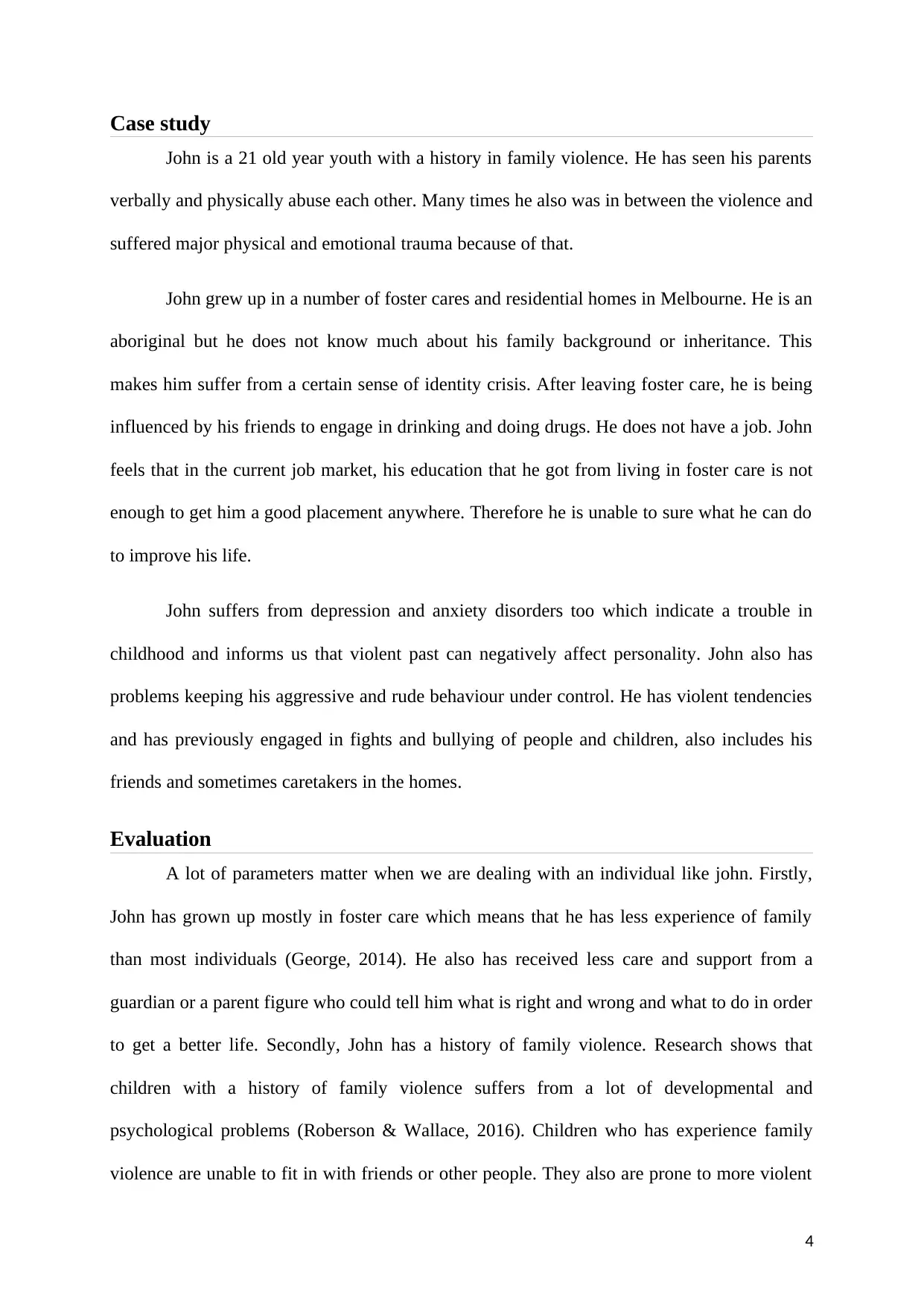
Case study
John is a 21 old year youth with a history in family violence. He has seen his parents
verbally and physically abuse each other. Many times he also was in between the violence and
suffered major physical and emotional trauma because of that.
John grew up in a number of foster cares and residential homes in Melbourne. He is an
aboriginal but he does not know much about his family background or inheritance. This
makes him suffer from a certain sense of identity crisis. After leaving foster care, he is being
influenced by his friends to engage in drinking and doing drugs. He does not have a job. John
feels that in the current job market, his education that he got from living in foster care is not
enough to get him a good placement anywhere. Therefore he is unable to sure what he can do
to improve his life.
John suffers from depression and anxiety disorders too which indicate a trouble in
childhood and informs us that violent past can negatively affect personality. John also has
problems keeping his aggressive and rude behaviour under control. He has violent tendencies
and has previously engaged in fights and bullying of people and children, also includes his
friends and sometimes caretakers in the homes.
Evaluation
A lot of parameters matter when we are dealing with an individual like john. Firstly,
John has grown up mostly in foster care which means that he has less experience of family
than most individuals (George, 2014). He also has received less care and support from a
guardian or a parent figure who could tell him what is right and wrong and what to do in order
to get a better life. Secondly, John has a history of family violence. Research shows that
children with a history of family violence suffers from a lot of developmental and
psychological problems (Roberson & Wallace, 2016). Children who has experience family
violence are unable to fit in with friends or other people. They also are prone to more violent
4
John is a 21 old year youth with a history in family violence. He has seen his parents
verbally and physically abuse each other. Many times he also was in between the violence and
suffered major physical and emotional trauma because of that.
John grew up in a number of foster cares and residential homes in Melbourne. He is an
aboriginal but he does not know much about his family background or inheritance. This
makes him suffer from a certain sense of identity crisis. After leaving foster care, he is being
influenced by his friends to engage in drinking and doing drugs. He does not have a job. John
feels that in the current job market, his education that he got from living in foster care is not
enough to get him a good placement anywhere. Therefore he is unable to sure what he can do
to improve his life.
John suffers from depression and anxiety disorders too which indicate a trouble in
childhood and informs us that violent past can negatively affect personality. John also has
problems keeping his aggressive and rude behaviour under control. He has violent tendencies
and has previously engaged in fights and bullying of people and children, also includes his
friends and sometimes caretakers in the homes.
Evaluation
A lot of parameters matter when we are dealing with an individual like john. Firstly,
John has grown up mostly in foster care which means that he has less experience of family
than most individuals (George, 2014). He also has received less care and support from a
guardian or a parent figure who could tell him what is right and wrong and what to do in order
to get a better life. Secondly, John has a history of family violence. Research shows that
children with a history of family violence suffers from a lot of developmental and
psychological problems (Roberson & Wallace, 2016). Children who has experience family
violence are unable to fit in with friends or other people. They also are prone to more violent
4
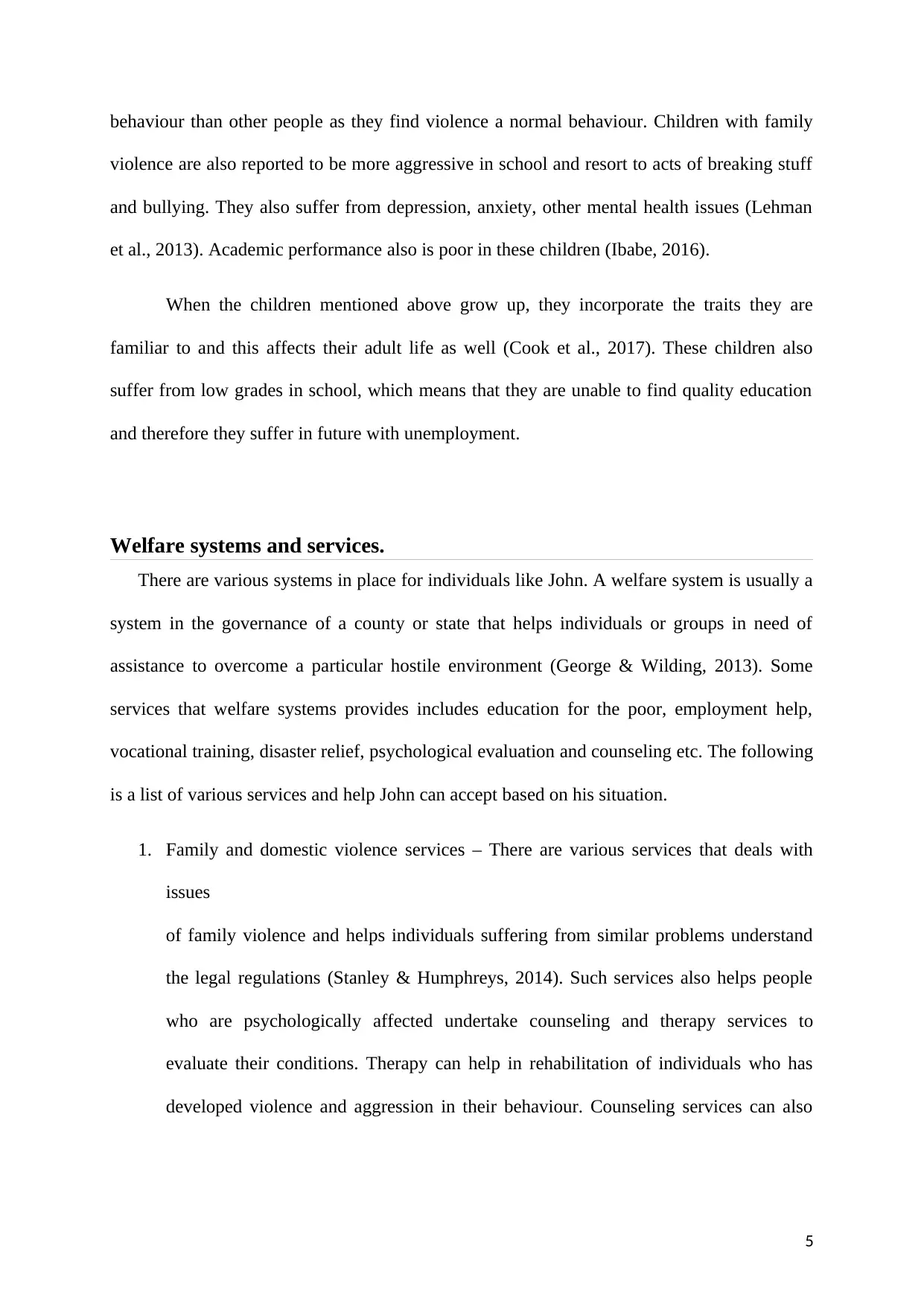
behaviour than other people as they find violence a normal behaviour. Children with family
violence are also reported to be more aggressive in school and resort to acts of breaking stuff
and bullying. They also suffer from depression, anxiety, other mental health issues (Lehman
et al., 2013). Academic performance also is poor in these children (Ibabe, 2016).
When the children mentioned above grow up, they incorporate the traits they are
familiar to and this affects their adult life as well (Cook et al., 2017). These children also
suffer from low grades in school, which means that they are unable to find quality education
and therefore they suffer in future with unemployment.
Welfare systems and services.
There are various systems in place for individuals like John. A welfare system is usually a
system in the governance of a county or state that helps individuals or groups in need of
assistance to overcome a particular hostile environment (George & Wilding, 2013). Some
services that welfare systems provides includes education for the poor, employment help,
vocational training, disaster relief, psychological evaluation and counseling etc. The following
is a list of various services and help John can accept based on his situation.
1. Family and domestic violence services – There are various services that deals with
issues
of family violence and helps individuals suffering from similar problems understand
the legal regulations (Stanley & Humphreys, 2014). Such services also helps people
who are psychologically affected undertake counseling and therapy services to
evaluate their conditions. Therapy can help in rehabilitation of individuals who has
developed violence and aggression in their behaviour. Counseling services can also
5
violence are also reported to be more aggressive in school and resort to acts of breaking stuff
and bullying. They also suffer from depression, anxiety, other mental health issues (Lehman
et al., 2013). Academic performance also is poor in these children (Ibabe, 2016).
When the children mentioned above grow up, they incorporate the traits they are
familiar to and this affects their adult life as well (Cook et al., 2017). These children also
suffer from low grades in school, which means that they are unable to find quality education
and therefore they suffer in future with unemployment.
Welfare systems and services.
There are various systems in place for individuals like John. A welfare system is usually a
system in the governance of a county or state that helps individuals or groups in need of
assistance to overcome a particular hostile environment (George & Wilding, 2013). Some
services that welfare systems provides includes education for the poor, employment help,
vocational training, disaster relief, psychological evaluation and counseling etc. The following
is a list of various services and help John can accept based on his situation.
1. Family and domestic violence services – There are various services that deals with
issues
of family violence and helps individuals suffering from similar problems understand
the legal regulations (Stanley & Humphreys, 2014). Such services also helps people
who are psychologically affected undertake counseling and therapy services to
evaluate their conditions. Therapy can help in rehabilitation of individuals who has
developed violence and aggression in their behaviour. Counseling services can also
5
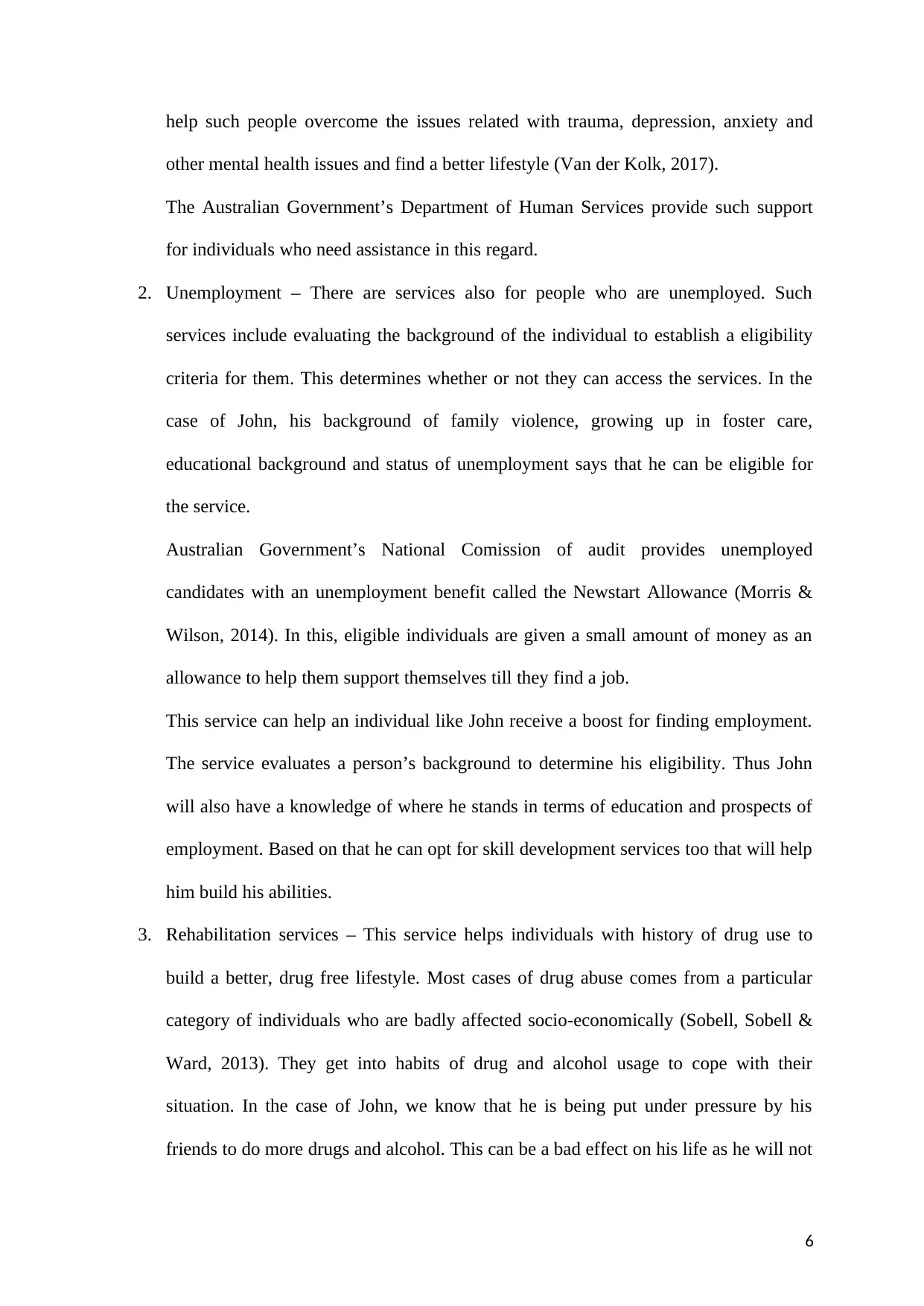
help such people overcome the issues related with trauma, depression, anxiety and
other mental health issues and find a better lifestyle (Van der Kolk, 2017).
The Australian Government’s Department of Human Services provide such support
for individuals who need assistance in this regard.
2. Unemployment – There are services also for people who are unemployed. Such
services include evaluating the background of the individual to establish a eligibility
criteria for them. This determines whether or not they can access the services. In the
case of John, his background of family violence, growing up in foster care,
educational background and status of unemployment says that he can be eligible for
the service.
Australian Government’s National Comission of audit provides unemployed
candidates with an unemployment benefit called the Newstart Allowance (Morris &
Wilson, 2014). In this, eligible individuals are given a small amount of money as an
allowance to help them support themselves till they find a job.
This service can help an individual like John receive a boost for finding employment.
The service evaluates a person’s background to determine his eligibility. Thus John
will also have a knowledge of where he stands in terms of education and prospects of
employment. Based on that he can opt for skill development services too that will help
him build his abilities.
3. Rehabilitation services – This service helps individuals with history of drug use to
build a better, drug free lifestyle. Most cases of drug abuse comes from a particular
category of individuals who are badly affected socio-economically (Sobell, Sobell &
Ward, 2013). They get into habits of drug and alcohol usage to cope with their
situation. In the case of John, we know that he is being put under pressure by his
friends to do more drugs and alcohol. This can be a bad effect on his life as he will not
6
other mental health issues and find a better lifestyle (Van der Kolk, 2017).
The Australian Government’s Department of Human Services provide such support
for individuals who need assistance in this regard.
2. Unemployment – There are services also for people who are unemployed. Such
services include evaluating the background of the individual to establish a eligibility
criteria for them. This determines whether or not they can access the services. In the
case of John, his background of family violence, growing up in foster care,
educational background and status of unemployment says that he can be eligible for
the service.
Australian Government’s National Comission of audit provides unemployed
candidates with an unemployment benefit called the Newstart Allowance (Morris &
Wilson, 2014). In this, eligible individuals are given a small amount of money as an
allowance to help them support themselves till they find a job.
This service can help an individual like John receive a boost for finding employment.
The service evaluates a person’s background to determine his eligibility. Thus John
will also have a knowledge of where he stands in terms of education and prospects of
employment. Based on that he can opt for skill development services too that will help
him build his abilities.
3. Rehabilitation services – This service helps individuals with history of drug use to
build a better, drug free lifestyle. Most cases of drug abuse comes from a particular
category of individuals who are badly affected socio-economically (Sobell, Sobell &
Ward, 2013). They get into habits of drug and alcohol usage to cope with their
situation. In the case of John, we know that he is being put under pressure by his
friends to do more drugs and alcohol. This can be a bad effect on his life as he will not
6
Paraphrase This Document
Need a fresh take? Get an instant paraphrase of this document with our AI Paraphraser
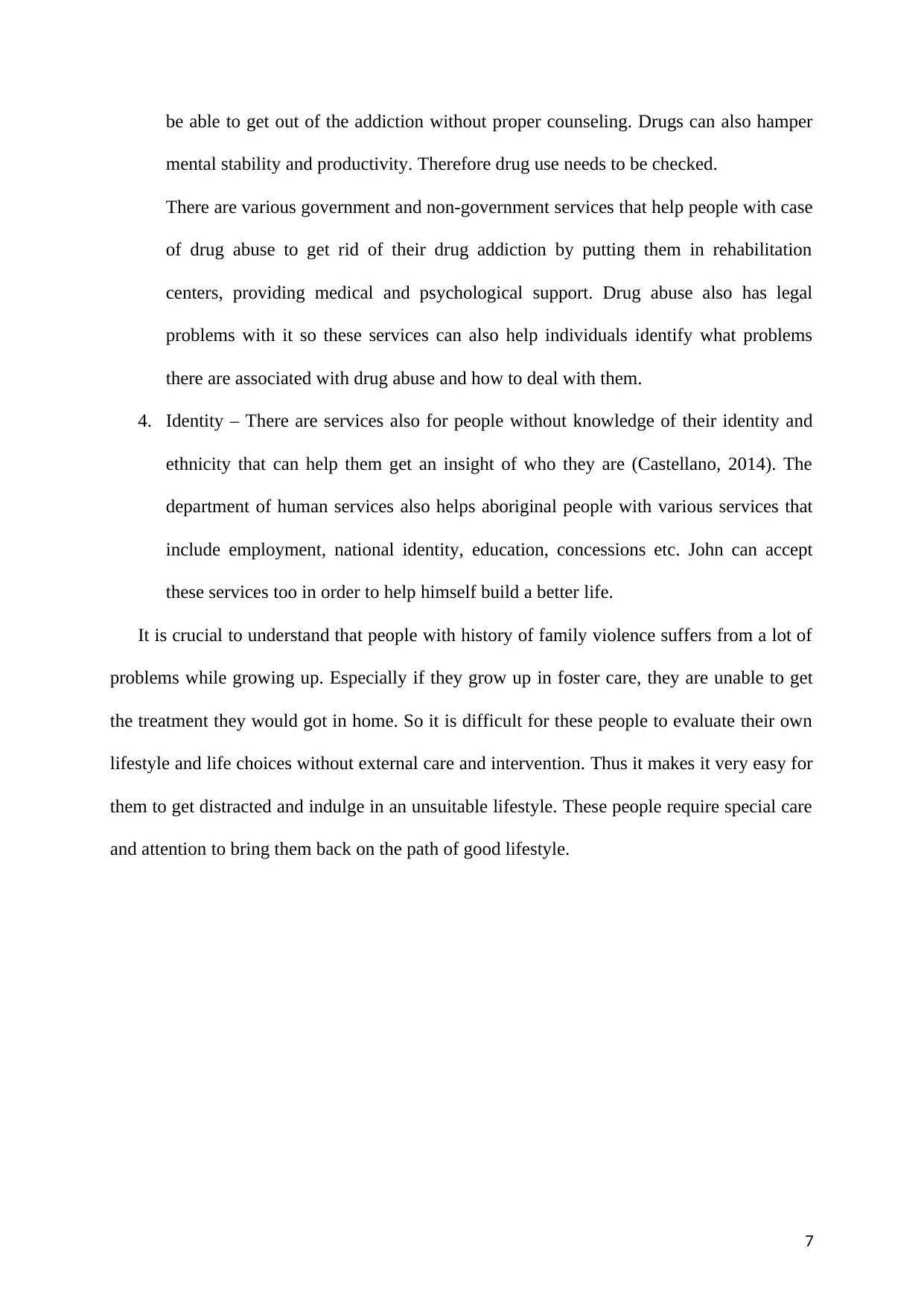
be able to get out of the addiction without proper counseling. Drugs can also hamper
mental stability and productivity. Therefore drug use needs to be checked.
There are various government and non-government services that help people with case
of drug abuse to get rid of their drug addiction by putting them in rehabilitation
centers, providing medical and psychological support. Drug abuse also has legal
problems with it so these services can also help individuals identify what problems
there are associated with drug abuse and how to deal with them.
4. Identity – There are services also for people without knowledge of their identity and
ethnicity that can help them get an insight of who they are (Castellano, 2014). The
department of human services also helps aboriginal people with various services that
include employment, national identity, education, concessions etc. John can accept
these services too in order to help himself build a better life.
It is crucial to understand that people with history of family violence suffers from a lot of
problems while growing up. Especially if they grow up in foster care, they are unable to get
the treatment they would got in home. So it is difficult for these people to evaluate their own
lifestyle and life choices without external care and intervention. Thus it makes it very easy for
them to get distracted and indulge in an unsuitable lifestyle. These people require special care
and attention to bring them back on the path of good lifestyle.
7
mental stability and productivity. Therefore drug use needs to be checked.
There are various government and non-government services that help people with case
of drug abuse to get rid of their drug addiction by putting them in rehabilitation
centers, providing medical and psychological support. Drug abuse also has legal
problems with it so these services can also help individuals identify what problems
there are associated with drug abuse and how to deal with them.
4. Identity – There are services also for people without knowledge of their identity and
ethnicity that can help them get an insight of who they are (Castellano, 2014). The
department of human services also helps aboriginal people with various services that
include employment, national identity, education, concessions etc. John can accept
these services too in order to help himself build a better life.
It is crucial to understand that people with history of family violence suffers from a lot of
problems while growing up. Especially if they grow up in foster care, they are unable to get
the treatment they would got in home. So it is difficult for these people to evaluate their own
lifestyle and life choices without external care and intervention. Thus it makes it very easy for
them to get distracted and indulge in an unsuitable lifestyle. These people require special care
and attention to bring them back on the path of good lifestyle.
7

Conclusion
Every country’s government has services that help people in need to live a better life.
A thorough study of those services as mentioned above, can really help an individual
overcome the problems they are facing. Early childhood education helps a lot in building a
future for people. But a troubled childhood and a history of violent family behaviour can
impact the way a person’s childhood is developed. In the case of John, his childhood was
troubled by family violence and it also put negative influence on his mind. Growing up in
foster care meant that those problems were never addressed in details and his caretakers were
not eligible to make sure that he received sufficient information and counseling along with
quality education. His friends also pressurize him to do drugs which is an effect of similar
incidents in their lifestyle and John can become like them if timely help is not given him. So it
becomes a responsibility for the government and various other organizations to ensure that
proper services are provided to these individuals so that they can be helped in their life.
8
Every country’s government has services that help people in need to live a better life.
A thorough study of those services as mentioned above, can really help an individual
overcome the problems they are facing. Early childhood education helps a lot in building a
future for people. But a troubled childhood and a history of violent family behaviour can
impact the way a person’s childhood is developed. In the case of John, his childhood was
troubled by family violence and it also put negative influence on his mind. Growing up in
foster care meant that those problems were never addressed in details and his caretakers were
not eligible to make sure that he received sufficient information and counseling along with
quality education. His friends also pressurize him to do drugs which is an effect of similar
incidents in their lifestyle and John can become like them if timely help is not given him. So it
becomes a responsibility for the government and various other organizations to ensure that
proper services are provided to these individuals so that they can be helped in their life.
8
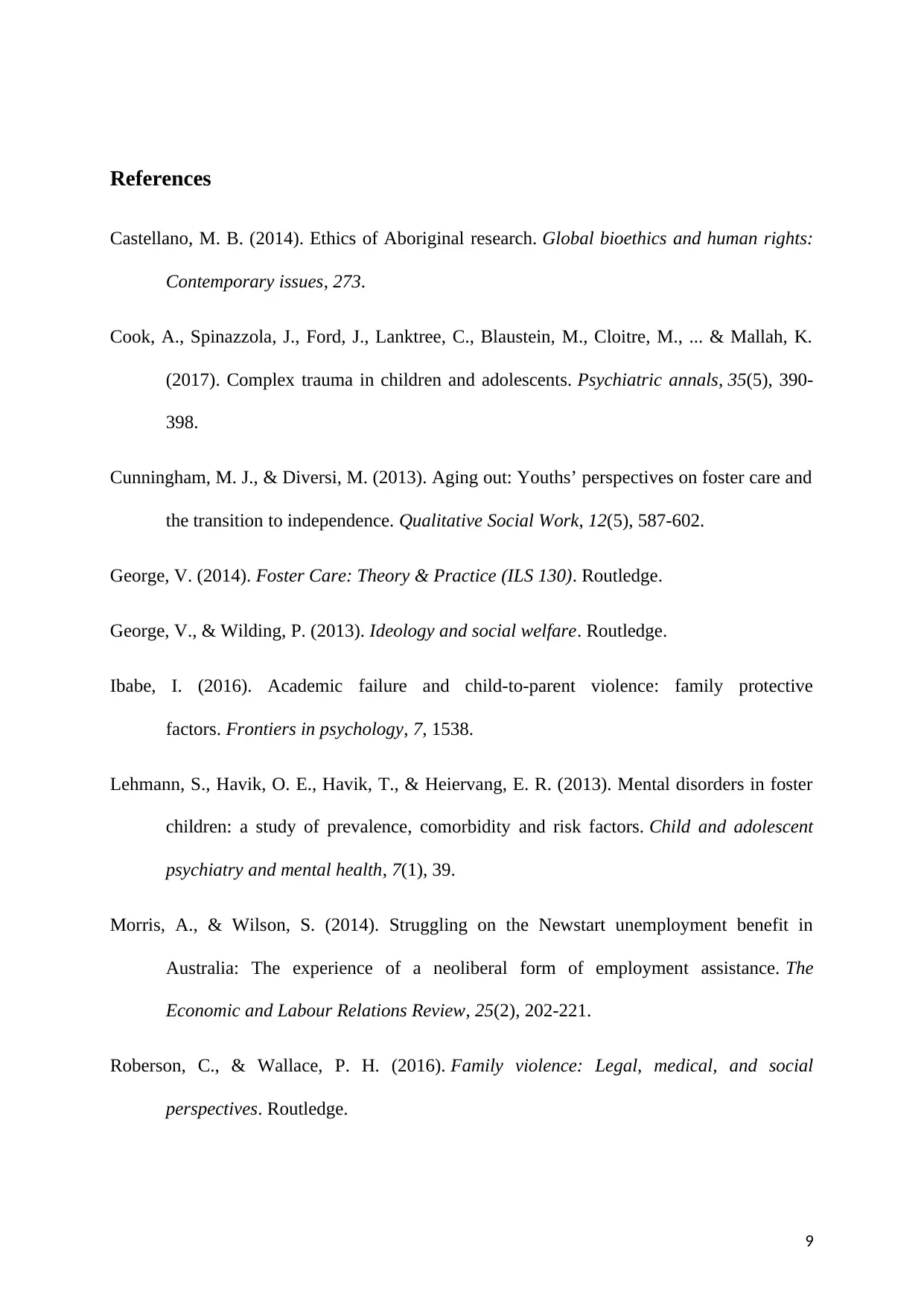
References
Castellano, M. B. (2014). Ethics of Aboriginal research. Global bioethics and human rights:
Contemporary issues, 273.
Cook, A., Spinazzola, J., Ford, J., Lanktree, C., Blaustein, M., Cloitre, M., ... & Mallah, K.
(2017). Complex trauma in children and adolescents. Psychiatric annals, 35(5), 390-
398.
Cunningham, M. J., & Diversi, M. (2013). Aging out: Youths’ perspectives on foster care and
the transition to independence. Qualitative Social Work, 12(5), 587-602.
George, V. (2014). Foster Care: Theory & Practice (ILS 130). Routledge.
George, V., & Wilding, P. (2013). Ideology and social welfare. Routledge.
Ibabe, I. (2016). Academic failure and child-to-parent violence: family protective
factors. Frontiers in psychology, 7, 1538.
Lehmann, S., Havik, O. E., Havik, T., & Heiervang, E. R. (2013). Mental disorders in foster
children: a study of prevalence, comorbidity and risk factors. Child and adolescent
psychiatry and mental health, 7(1), 39.
Morris, A., & Wilson, S. (2014). Struggling on the Newstart unemployment benefit in
Australia: The experience of a neoliberal form of employment assistance. The
Economic and Labour Relations Review, 25(2), 202-221.
Roberson, C., & Wallace, P. H. (2016). Family violence: Legal, medical, and social
perspectives. Routledge.
9
Castellano, M. B. (2014). Ethics of Aboriginal research. Global bioethics and human rights:
Contemporary issues, 273.
Cook, A., Spinazzola, J., Ford, J., Lanktree, C., Blaustein, M., Cloitre, M., ... & Mallah, K.
(2017). Complex trauma in children and adolescents. Psychiatric annals, 35(5), 390-
398.
Cunningham, M. J., & Diversi, M. (2013). Aging out: Youths’ perspectives on foster care and
the transition to independence. Qualitative Social Work, 12(5), 587-602.
George, V. (2014). Foster Care: Theory & Practice (ILS 130). Routledge.
George, V., & Wilding, P. (2013). Ideology and social welfare. Routledge.
Ibabe, I. (2016). Academic failure and child-to-parent violence: family protective
factors. Frontiers in psychology, 7, 1538.
Lehmann, S., Havik, O. E., Havik, T., & Heiervang, E. R. (2013). Mental disorders in foster
children: a study of prevalence, comorbidity and risk factors. Child and adolescent
psychiatry and mental health, 7(1), 39.
Morris, A., & Wilson, S. (2014). Struggling on the Newstart unemployment benefit in
Australia: The experience of a neoliberal form of employment assistance. The
Economic and Labour Relations Review, 25(2), 202-221.
Roberson, C., & Wallace, P. H. (2016). Family violence: Legal, medical, and social
perspectives. Routledge.
9
Secure Best Marks with AI Grader
Need help grading? Try our AI Grader for instant feedback on your assignments.
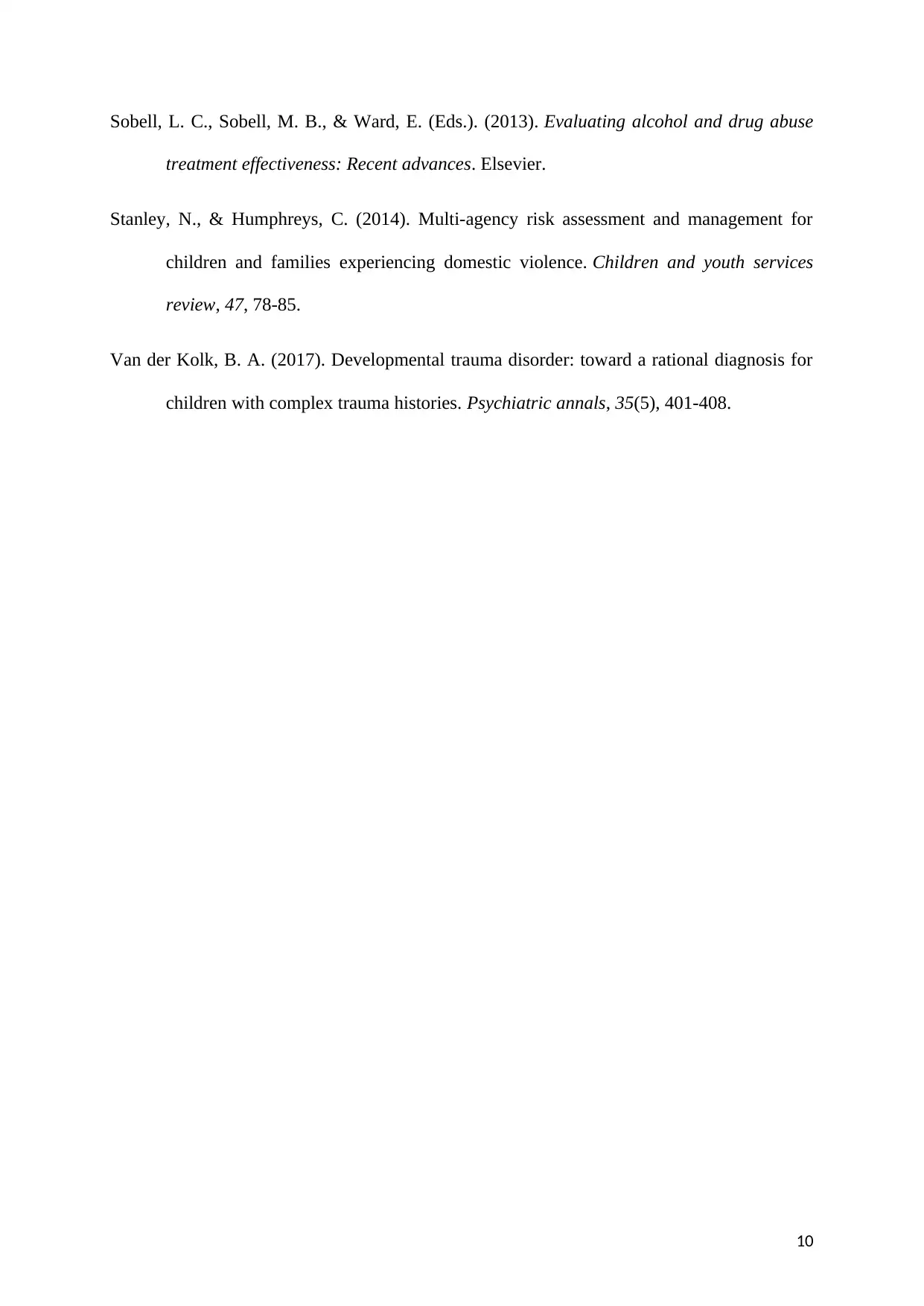
Sobell, L. C., Sobell, M. B., & Ward, E. (Eds.). (2013). Evaluating alcohol and drug abuse
treatment effectiveness: Recent advances. Elsevier.
Stanley, N., & Humphreys, C. (2014). Multi-agency risk assessment and management for
children and families experiencing domestic violence. Children and youth services
review, 47, 78-85.
Van der Kolk, B. A. (2017). Developmental trauma disorder: toward a rational diagnosis for
children with complex trauma histories. Psychiatric annals, 35(5), 401-408.
10
treatment effectiveness: Recent advances. Elsevier.
Stanley, N., & Humphreys, C. (2014). Multi-agency risk assessment and management for
children and families experiencing domestic violence. Children and youth services
review, 47, 78-85.
Van der Kolk, B. A. (2017). Developmental trauma disorder: toward a rational diagnosis for
children with complex trauma histories. Psychiatric annals, 35(5), 401-408.
10
1 out of 11
Related Documents
Your All-in-One AI-Powered Toolkit for Academic Success.
+13062052269
info@desklib.com
Available 24*7 on WhatsApp / Email
![[object Object]](/_next/static/media/star-bottom.7253800d.svg)
Unlock your academic potential
© 2024 | Zucol Services PVT LTD | All rights reserved.





